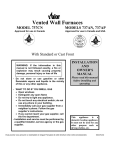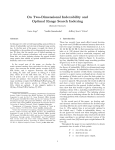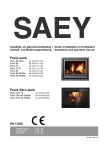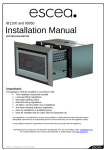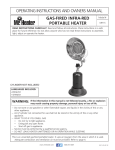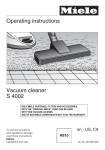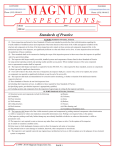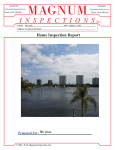Download Valor 737CN Owner`s manual
Transcript
Vented Gas Fireplace Heaters Models 737XN & 737XP with Standard or Cast Front Installation and Owner’s Manual Please read this manual before installing and operating this heater This manual should remain with the homeowner WARNING: If the information in these instructions is not followed exactly, a fire or explosion may result causing property damage, personal injury or loss of life. - Do not store or use gasoline or other flammable vapors and liquids in the vicinity of this or any other appliance. This appliance is a domestic room heating appliance. It must not be used for any other purpose such as drying clothes etc. This appliance is suitable for installation in a bedroom or bed sitting room where not prohibited by local codes. -WHAT TO DO IF YOU SMELL GAS Do not try to light any appliance. Do not touch any electrical switch: do not use any phone in your building. • Immediately call your gas supplier from a neighbor’s phone. Follow the gas supplier’s instructions. • If you cannot reach your gas supplier, call the fire department. • • - Installation and service must be performed by a qualified installer, service agency or the gas supplier. 600B280/02 CONTENTS 1. 2. SAFETY INFORMATION.......................................................................................................................................................................................... 3 OPTIONS ....................................................................................................................................................................................................................... 4 2.1. Additional optional features ............................................................................................................................................................................... 4 3. GENERAL....................................................................................................................................................................................................................... 5 3.1. Approvals & codes ................................................................................................................................................................................................. 5 3.2. Appliance data........................................................................................................................................................................................................ 5 4. LOCATION IN THE ROOM .................................................................................................................................................................................... 6 5. SUPPLY GAS ................................................................................................................................................................................................................. 8 6. PACK CONTENTS...................................................................................................................................................................................................... 9 7. INSTALLATION ........................................................................................................................................................................................................ 10 7.1. Pre-installation preparation ............................................................................................................................................................................. 10 7.2. Install to fireplace................................................................................................................................................................................................ 11 7.3. Installation of gas supply ................................................................................................................................................................................... 11 7.4. Switch to front frame installation.................................................................................................................................................................... 12 7.5. Optional trim installation.................................................................................................................................................................................. 12 7.6. Front frame & switch to appliance .................................................................................................................................................................. 14 7.7. Heat shields installation – Cast front only..................................................................................................................................................... 15 7.8. Ceramic fuel bed installation ........................................................................................................................................................................... 16 7.9. Operation checks ................................................................................................................................................................................................. 17 7.10. Fascia installation ................................................................................................................................................................................................ 17 7.11. Venting check ....................................................................................................................................................................................................... 18 7.12. Final check ............................................................................................................................................................................................................ 18 8. OPERATING PROCEDURE .................................................................................................................................................................................. 19 8.1. General operating notes..................................................................................................................................................................................... 19 8.2. Cleaning................................................................................................................................................................................................................. 19 8.3. Checks ................................................................................................................................................................................................................... 21 8.4. Servicing ................................................................................................................................................................................................................ 21 8.5. General servicing ................................................................................................................................................................................................. 21 2 1. SAFETY INFORMATION WARNING: Do not operate the appliance with the glass front removed, cracked or broken. Replacement of the glass should be done by a licensed or qualified service person. (The whole window unit may be temporarily removed by the owner for cleaning the interior of the firebox, etc.) Only the authorized Valor replacement window unit listed in the repair parts booklet must be fitted - never use substitutes. If the glass is damaged search inside and adjacent to the appliance for any glass fragments. Keep the appliance area well clear and free from combustible materials, gasoline and other flammable vapors and liquids. Due to high temperatures, the appliance should be located out of traffic and away from furniture and draperies. Keep the base of the appliance clear to prevent obstruction of air flow to the appliance. Children and adults should be alerted to the hazards of high surface temperatures and should stay away to avoid burns or clothing ignition. This appliance must be properly connected to a venting system. It is equipped with a vent safety shutoff system. Operating when not connected to a properly installed and maintained venting system or tampering with the shutoff system can result in carbon monoxide (CO) poisoning and possible death. The venting system should be checked periodically. Recent trends in home improvement and new tighter construction techniques have contributed to problems with venting. If you suspect that your appliance is not venting properly, do not operate. Seek expert advice. If any changes are made to the room construction in the vicinity of the appliance after installation (e.g. additional mantle etc.) make sure that the changes conform to the installation requirements in this manual. Never attempt to burn paper or any other material in the appliance. Young children should be carefully supervised when they are in the same room as the appliance. Clothing or other flammable material should not be placed on or near the appliance. This appliance must be installed and repaired by a qualified service person. The appliance should be inspected before use and at least annually by a professional service person. More frequent cleaning may be required due to excessive lint from carpeting, bedding material, etc. It is imperative that control compartments, burners and circulating air passageways of the appliance are kept clean.This appliance should be installed and repaired by a qualified service person. Do not use this appliance if any part has been under water. Immediately call a qualified service technician to inspect the appliance and to replace any part of the control system and any gas control which has been under water. Keep curtains, clothing, furniture and other flammable materials a safe distance from all parts of the appliance. NOTE When operating your new furnace for the first time, some vapors may be released which may cause a slight odor and could possibly set off any smoke detection alarms in the immediate vicinity. These vapors are quite normal on new appliances. They are totally harmless and will disappear after a few hours use. 3 2. OPTIONS Heater engine unit 737XN is supplied for all natural gas installations. Heater engine unit 737XP is supplied for all propane installations. One of the following fascias is supplied with each appliance: #772SIF Standard fascia #774CIF Cast fascia 2.1. Additional optional features #785BAT Brass trim kit for fascia Facia outer surrounds #777FSK 4” Black beveled trim – 3 sided #778FSK 2½” Contoured black trim – 3 sided #779FSK 2½” Contoured champagne trim – 3 sided #781FSK 2½” Contoured black trim – 4 sided #782FSK 2½” Contoured champagne trim – 4 sided #783FSK 2½” Contoured etched champagne trim – 3 sided #784FSK 2½” Contoured burgundy trim – 3 sided #785FSK 2½” Contoured blue trim – 3 sided #786FSK 2½” Contoured green trim – 3 sided #787FSK 4” Black beveled trim – 4 sided #788FSK 2½” Contoured etched champagne trim – 4 sided #789FSK 2½” Contoured burgundy trim – 4 sided #790FSK 2½” Contoured blue trim – 4 sided #791FSK 2½” Contoured green trim – 4 sided Circulating fan kit #796CFK Operated by a 3 position switch, the fan is designed to boost the natural convection process through the heater. This may be a desirable feature dependent on the fireplace location and room layout. The circulating fan may be installed during initial appliance installation or as a retrofit at a later date. Full installation and operating instructions are included with the kit. Zero clearance kit #770ZCK Allows the furnace to be installed into an enclosure constructed of combustible material. The kit must be used in this form of enclosure. Enclosure framing dimensions suitable for the kit are shown in section 4 of this manual. This zero clearance kit has been designed to act as a “rough in” box with the appliance model 737X purchased and/or fitted after the walls of the enclosure and the hearth have been fitted. Full installation instructions are included with the kit. Clearance reduction baffle #771CRB Allows combustible mantles to be fitted closer to the fireplace. Full installation instructions are included with the kit. 4 3. GENERAL 3.1. Approvals & codes This appliance is certified by International Approval Services for use in Canada and the USA. The appliance is for installation connected to an approved 3” dia. liner or B-vent. The appliance complies with CGA P.4.1, Testing method for measuring annual fireplace efficiencies. The installation must conform with local codes or, in the absence of local codes with the National Fuel Gas Code, ANSI Z223.1or the Canadian installation code CAN/CGA-149. Only qualified licensed or trained personnel should install the appliance. The appliance, when installed, must be electrically grounded in accordance with local codes or, in the absence of local codes, with the National Electrical Code, ANSI/NFPA 70 or the Canadian Electrical Code, CSA C22.1 3.2. Appliance data Altitude (ft) 0-2000 Input (Btu/h) 2000-4500 0-2000 Output-Fan Off 2000-4500 0-2000 Output-Fan On 2000-4500 Supply-Upstream of Regulator (in w.c.) Manifold-Tapping on Thermostat (Appliance full on) (in w.c.) Pilot orifice Type No. of holes Front burner Type orifice No. of holes Rear burner Type orifice No. of holes 737XN Max. Min. 28,900 9,860 20,519 21,390 10.5 5.0 4.0 3.6 737XP Max. Min. 28,400 17,000 25,045* 15,180* 20,166 17,782* 21,443 18,910* 14.0 11.0 9.5 9.1 Cat 960-45 1 Cat 82-360 Cat 960-15 1 Cat 92-130 7 Cat 82-440 1 Cat 960-190 7 1 * After adjustment 5 4. LOCATION IN THE ROOM The appliance can be installed in the following constructions: 2.1 Solid fuel (Non-combustible) fireplaces As supplied, this appliance can be installed as an inset in an existing solid fuel type fireplace with a chimney and 3" dia liner (see fig.1a). The fireplace must be built in accordance with the national, state provincial or territorial building code recognized by the authority having jurisdiction, or in the absence of such a code, in accordance with the National Building Code of Canada or the National Fire Protection Association code in the USA The size of the fireplace recess must be sufficient to accommodate the appliance case as shown in fig.1a. The chimney must be swept and both chimney and fireplace checked for soundness before installation of the appliance. The liner must be a type approved by the enforcing authority and installed in accordance with the manufacturer's instructions. The appliance must be installed on a non-combustible floor. The floor must be sufficiently flat and level to support the appliance satisfactorily. Some fireplace constructions have a well in the floor at the back that may need to be filled in. In the USA it is mandatory that a hard surfaced non-combustible hearth area must be maintained at least 16" in front of the fireplace. This may be finished in brick, ceramic tile, marble, etc. Raising the hearth slightly will help to minimize dust and lint accumulation under the unit. In Canada, though not mandatory, we recommend that carpet, soft vinyl or other combustible floor coverings are kept at least 16” from the front of the furnace since these types of materials may be affected by the high radiant heat output from this appliance. The minimum clearances from any combustible constructions at the front of the appliance are shown in fig.1b. These front clearances apply for all installations. 2.2 Enclosures constructed with combustible materials #770ZCK Zero clearance kit must be installed where the furnace is intended to be in an enclosure made with wood studding or other combustible materials. The enclosure framing requirements are shown in figures 1c through 1f. Note that in Canada, though not mandatory, we recommend that carpet, soft vinyl or other combustible floor coverings are kept at least 16” from the front of the furnace since these types of materials may be affected by the high radiant heat output from this appliance. Fig. 1a Solid fuel fireplace dimensions 6 MANTLE DEPTH “A” CLEARANCE FROM BASE OF HEATER “B” 1” 2” 3” 4” 5” 6” 7” 37 7/8” 39 7/8” 40 7/8” 42 7/8” 44 7/8” 46 7/8” 48 7/8” Fig. 1b Clearances to combustible materials in front of enclosure opening - All installations Fig 1d Combustible material enclosure - For installations in Canada with unprotected combustible floor Fig 1c Combustible material enclosure - For installations in USA with protected combustible floor 7 Fig 1e Combustible material enclosure - For installations in USA with unprotected combustible floor Fig 1f Combustible material enclosure with #770ZCK kit in position 5. SUPPLY GAS Models 737XN is for use with natural gas only. Model 737XP is for use with propane only. The supply pressure must be between the limits shown in section 3.2 of this manual The supply connection is 3/8”NPT. The supply gas feed line should enter the appliance through one of the openings in the appliance case. Openings are at the back and left side. (see fig.2). Fig. 2 Gas connection openings in case 8 6. PACK CONTENTS #785 Brass trim kit (Additional option) 1 Top trim strip 1 Left side trim strip 1 Right side trim strip 10 Spring fasteners Appliance engine unit (For all appliances) 1 Main appliance fitted with window. 2 Ceramic logs. 2 Ceramic firebox side walls. 4 Ceramic base bricks. 1 Ceramic firebox back wall. 1 Switch & battery box unit 4 1.5V AA Batteries 2 Case levelling screws 2 Lock nuts for levelling screws 4” Bevelled outer trim kit – 3 sided (Additional option) #777FSK 1 Outer surround top channel. 2 Outer surround side channels. 1 Bag of screws, nuts, and washers for outer surround fixing. #772SIF Standard fascia (Alternative) 1 Front frame 1 Bottom lover unit 1 Inner front unit 1 Rocker switch mounting bracket 1 Rocker switch heat shield 4 Screws for front unit fixing 2 Thread forming screws for heat shield 1 Control knob extension 4” Bevelled outer trim kit – 4sided (Additional option) #787FSK 2 Outer surround top channel. 2 Outer surround side channels. 1 Bag of screws, nuts, and washers for outer surround fixing. 21/2” Contoured trim - 3 sided (Additional option) #778FSK - black #779FSK - champagne #783FSK – etched champagne #784FSK - burgundy #785FSK - blue #786FSK - green 1 Outer surround top channel. 1 Outer surround left side channel. 1 Outer surround right side channel. 2 Outer corner fixing brackets. 2 Inner corner fixing brackets. 1 Bag of screws for outer surround fixing. #774CIF Cast fascia (Alternative) 1 Front frame 1 Upper front unit 1 Bottom front unit 1 Bottom front heat shield 1 Thermostat phial shield 1 Rocker switch mounting bracket 1 Rocker switch heat shield 4 Screws for front unit fixing 6 Thread forming screws for heat shields 1 Control knob extension 21/2” Contoured trim - 4 sided (Additional option) #781FSK - black #782FSK - champagne #788FSK – etched champagne #789FSK - burgundy #790FSK - blue #791FSK - green 2 Outer surround top channel. 1 Outer surround left side channel. 1 Outer surround right side channel. 4 Outer corner fixing brackets. 4 Inner corner fixing brackets. 1 Bag of screws for outer surround fixing. 9 7. INSTALLATION 7.1. Pre-installation preparation For installations in enclosures constructed with combustible materials, complete the enclosure and install the #770ZCK zero clearance kit in accordance with the instructions supplied with the kit. 7.1.1 Closing Large Fireplace Openings This appliance is suitable for solid fuel fireplace openings within the sizes shown in figure 1a. Larger fireplace openings may be reduced or the outer surround plate extended using non-combustible materials. 7.1.2 Remove Window and Logs (see fig.3). • Detach the window unit by removing the two screws situated at the bottom corners of the unit. • Lift the window unit up and forwards to unhook the top. Put the window in a safe place. • Take the ceramic logs out of the firebox and store in a Fig. 3 Window removal (Shown with Standard Front Frame) safe place. 7.1.3 Check Ignition Electrode Spark. The pilot burner and electrode unit is at the right end of the burner. Push in the lighting knob and turn counter-clockwise through the “IGN” position to “PILOT”. A spark should flash across from the pilot electrode to the pilot burner shield. See figure 4. 7.1.4 Check flame control motor. • Fit the four batteries into the battery box (Which is attached to the switch wires). • Temporarily connect the black connector pad to the control unit – See figure 5. • Operate the switch. This should cause the flame control knob to rotate counter-clockwise. See figure 5. • Disconnect and remove after checking. Fig. 4 Pilot ignition system 7.1.5 Remove the Vent Connection Unit. Detach the vent connection unit from the top of the appliance case by removing the screw at front. Slide the vent connection unit back and lift clear (see fig.6). 7.1.6 Fit the control knob extension firmly over the gas control knob. (See fig.7) Fig. 7 Control knob extension Fig. 5 Fig. 6 Vent connector removal 10 7.1.7 7.1.8 Check gas supply line routing Openings for the gas supply line are provided at the back and left side of the appliance case (see figure 2). The appliance is supplied with a plate covering the back opening. The opening at the left side is uncovered as supplied. If the supply line is to enter through the back, remove the plate and refit to the side opening. Fit case levelling screws if necessary. Place the appliance in position in the fireplace opening and check for stability. If necessary fit a levelling screw and lock nut into the threaded holes neasr the rear corners of the case. Adjust the screws to level the appliance. 7.2. Install to fireplace 7.2.1 7.2.2 7.2.3 7.2.4 Secure the collar on the vent connector unit to the 3" diameter chimney liner (Fig. 8). Slide the fire unit into the fireplace making sure that the vent connection unit is above the appliance case. Leave the case front a few inches clear of the fireplace front to allow you to fix the vent connector to the top of the case. Pull the vent connector towards the front of the fireplace and locate the rear slot in the plate on the lip at top rear of the appliance case. Fix the front of the vent connector plate to the appliance case top using the screw previously removed (Fig.8). Push the appliance fully home against the front face of the fireplace. Make sure that no sags or dips occur in the liner. Fig. 8 Vent connector & liner attachment 7.3. Installation of gas supply 7.3.1 7.3.2 7.3.3 For access to the connection elbow, detach the log support tray by removing two screws then detach the access cover plate by removing two screws – See fig. 9. Use only new black iron or steel pipes or copper tubing if acceptable. Check local codes. Note: In USA copper tubing must be internally tinned for protection against sulfur compounds. Unions in gas lines should be of ground joint type. The gas supply line must be sized and installed to provide a supply of gas sufficient to meet the maximum demand of the appliance without undue loss of pressure. Sealants used for natural gas models as well as propane versions must be Fig. 9 resistant to the action of all gas constituents including L.P. gas. Sealants should be applied lightly to male threads to ensure excess sealant does not enter gas lines. The supply line should include a manual shut-off valve and union in the line to allow the appliance to be disconnected for servicing. A plugged 1/8" NPT tapping must be installed in the line. The tapping must be accessible for test gauge connection and be immediately upstream of the gas supply connection to the appliance. All piping and connections must be tested for leaks after installation or servicing. All leaks must be corrected immediately. When testing for leaks:a. Make sure that the appliance control knob is at the OFF position. b. Open the manual shut-off valve. c. Test for leaks by applying a liquid detergent or soap solution to all joints. Bubbles forming indicate a gas leak. NEVER USE AN OPEN FLAME TO CHECK FOR LEAKS. d. Correct any leak detected immediately. Refit the access cover plate and log support tray after connecting the gas supply. 11 7.4. Switch to front frame installation 7.4.1 Thread the switch wires through the rocker switch mounting bracket. Snap fit the switch to the bracket with the switch positioned so that the terminals with two soldered wires are at the bottom when the two legs of the bracket are at the left side when viewed from the front – See fig. 10. This will ensure that pressing the top of the rocker switch raises the flame setting. 7.4.2 Fit the switch mounting bracket to the top left side of the front frame with the bracket legs in the slot in the frame – See fig. 11. 7.4.3 Fit the rocker switch heat shield over the switch and bracket. Align the Fig. 10 holes in the shield with those in the bracket and secure with two thread forming screws – see figure 12. 7.5. Optional trim installation 7.5.1 #785 Brass trim – See fig. 13 Fit the top, left and right side trims over the front frame. Align the holes in the frame and trims. Secure with the spring fasteners using four across the top and three each side. The flat face of the fasteners should be on the outside. Fig. 11 Fig.12 Fig. 13 12 7.5.2 With #777FSK 4” beveled trim 7.5.2.1 Assemble the two outer surround sides to the top cross piece using four nuts, screws and washers provided (fig. 14). 7.5.2.2 Attach the outer facia to the front frame with the four nuts, bolts and washers supplied (fig. 15). 7.5.3 With #778FSK or #779FSK 2½” contoured trim 7.5.3.1 Assemble the left and right side channels to the top channel using the inner and outer corner fixing brackets and 12 thread cutting screws provided (fig.16). 7.5.3.2 Attach the outer facia to the front frame with 4 thread cutting screws provided (fig.17). Fig. 14 Fig. 17 Fig. 16 Fig. 15 13 7.6. Front frame & switch to appliance 7.6.1 Attach the front frame to the case with four screws – See figure 18. 7.6.2 Remove the screw from the right side of the battery compartment and pull the compartment side to the right to allow the wires to be fed through – See fig. 19. 7.6.3 For active appliance side switch as only active switch – See fig. 19 7.6.3.1 Detach the plastic battery holder. Route the wires into the battery compartment. Feed the “L” terminals and connector block through the back right corner of the compartment. Leave the connector pads in the compartment. 7.6.3.2 Connect the “L” terminals to the control unit. 7.6.3.3 Connect the battery box to the black connection pad. 7.6.3.4 Place the battery box on the “Velcro” pad in the battery compartment. 7.6.3.5 Refit the compartment side with one screw. 7.6.4 For active remote control without active appliance switch Caution! Don’t connect the batteries in the remote control receiver until the wires are connected to the burner control unit. A short circuit could result in destruction of the electrical components. The rocker switch should be fitted to the front frame for aesthetic purposes but leave the wires from the switch disconnected. 7.6.4.1 Route the wires from the receiver through the back right corner of the battery compartment and connect to the control unit. 7.6.4.2 Remove the receiver lid. Connect the battery box to the receiver wires. Fit the four 1.5 V batteries. Replace the receiver lid. Fig. 19 7.6.4.3 Place the remote control receiver on the “Velcro” pad in the battery compartment – See fig. 20. 7.6.4.4 Fit the 9V battery to the handset transmitter. 7.6.4.5 Refit the compartment side with one screw. 7.6.5 For active remote control with active appliance side switch Caution! Don’t connect the batteries in the remote control receiver until the wires are connected to the burner control unit. A short circuit could result in destruction of the electrical components. A set of four batteries and battery box is supplied with the appliance and a further set with the remote control unit. Fig. 20 Only one set is required. The other set can be kept by the owner as 7.6.5.1 Detach the plastic battery holder. 7.6.5.2 Cut off the “L” terminals from the switch wires on the remote control receiver and remove insulation from approximately ¼” at ends of wires. See figure 21. 7.6.5.3 Securely connect the wires to the terminal block. Connect the black wire to the terminal opposite the brown wire. Connect the wire with the white stripe to the terminal opposite the yellow wire. See figure 22. 7.6.5.4 Route the wires into the battery compartment. Feed the “L” terminals and connector block through the back right corner of the compartment. Leave the Figure 22 connector pads in the compartment. 7.6.5.5 Remove the remote control receiver lid. Remove the cover from the white connection pad. Fit this connection pad to the remote control receiver terminals. See figure 23. 7.6.5.6 Fit the black connection pad to a battery box. Fit four 1.5V batteries. See figure 23. Place the batteries and connection pad in the receiver box and replace the lid. 7.6.5.7 Fit the 9V battery to the handset transmitter. 7.6.5.8 Refit the compartment side with one screw. Figure 23 14 Fig. 18 Figure 21 spares. 7.7. Heat shields installation – Cast front only 7.7.1 Fit the phial heat shield over the thermostat phial with two screws – See fig. 24. 7.7.2 Fit the bottom front heat shield to and below the black burner box tray – See fig. 25. Fig. 24 Fig. 25 15 7.8. Ceramic fuel bed installation 7.8.1 Install the ceramic rear wall at the back of the firebox (see fig.26). The wall has “BASE” embossed at the bottom. Make sure that the wall is behind the metal channel at top of the firebox 7.8..2 Install the ceramic side walls. The side walls are left and right handed. Rest the bottom edges of the side walls on the firebox side supports. Locate the top edges of the side walls in the gaps between the edges of the top heat baffle and the firebox sides. Slide the side walls fully back to touch the rear wall (fig. 27). 7.8.3 Install the front base bricks. (The right hand brick has a small notch). Place the bricks on the firebox front ledge with the front face of the bricks behind the lip at front of the ledge. Their inner ends should rest on the centre angled support and their outside ends Fig. 26 should be under the cut-outs at the front of the side walls (fig. 28). 7.8.4 Install the side base bricks. These bricks are left and right handed. Place the side base bricks on the firebox side supports. The recess in the inside edge of each brick should locate behind the vertical metal edge of the each side support (fig. 29) 7.8.5 Install the front log. The front edge of the log should rest behind the vertical metal edge of the firebox base which is behind the front base bricks and front burner tube. Be aware that there should be a gap between the right side of the front log and the right side base brick. There should be no gap at the left side (fig 30). 7.8.6 Install the rear log in the two supports at the rear of the firebox. Make sure that the log is fully located in the “V” forms of the supports (fig. 31). 7.8.7 Refit the window Fig. 27 Side wall location Hook the top of the window frame over the firebox top front edge. Secure the window unit in place by refitting two screws at the bottom corners of the unit. Fig. 28 Front base bricks Fig. 29 Side base bricks Fig. 31 Rear log Fig. 30 Front log 16 7.9. Operation checks 7.9.1. System pressure check The appliance is pre-set to give the correct heat input with the gas for which it is designed. The burner manifold pressure is controlled by a built-in non-adjustable regulator. The gas supply pressure to the appliance inlet and the manifold pressure must be between the figures shown in section 3.2. The manifold pressure should be checked at the pressure test point which is located on a “T” piece between the control valve and the burner selector knob. The pressure check should be made with both burners alight and the thermostat at its highest setting. Fig. 32 Aeration shutters 7.9.2. Supply line pressure check The appliance and its individual shut-off valve must be disconnected from the gas supply piping system during any pressure testing of that system at test pressures in excess of 1/2 psig (3.5kPa). The appliance must be isolated from the gas supply piping system by closing its individual manual shut off valve during any pressure testing of the gas supply piping system at test pressures equal to or less than 1/2 psig (3.5kPa). 7.9.3. Burner operation check Check ignition, pilot stability, burner selection control, burner flames and the Fig. 33 Bottom Louver Attachment (Standard fascia) full range of the thermostat using the rotary switch inside the appliance and all other controls (appliance rocker switch, remote hand unit). See owner’s lighting instructions further on in this manual for full details. 7.9.4. Aeration adjustment On natural gas appliances (Model 737XN) both front and rear burners are equipped with adjustable shutters to control primary aeration. The air holes are at the right side of the front and rear burner rails - See fig 32. The shutters can slide to the right to reduce the air supply or to the left to increase it. The appliance is supplied with the shutters set to suit the vast majority of installations. No adjustment should usually be necessary. However, in certain installations (e.g. Low Btu value gas, high altitude) it may be necessary to adjust the shutter position of one or both of the burners to obtain the optimal visual effect. Aeration is not adjustable on Propane appliances (Model #737XP) 7.10. Fascia installation Fig. 34 Inner front unit attachment 7.10.1. Standard fascia (Standard fascia) 7.10.1.1 Hook the bottom louver unit on to the brackets near the bottom of the frame sides (see fig. 33). Take care not to trap any wires or thermostat parts between the frame and appliance case. 7.10.1.2 Locate the hooks on the inner front unit into the slots at each side of the fire box. Push the inner front fully downwards (fig. 34). 7.10.2. Cast fascia 7.10.2.1 Attach the bottom front casting by hooking the two steel locators at back of the casting over the brackets at the bottom of the front frame sides (see fig. 35). Check that the swing door opens and shuts correctly. 7.10.2.2 Rest the upper front casting on the bottom casting. Then slightly lift the upper casting and attach it to the appliance by hooking the two steel locators at back of the casting over the brackets inside the top corners of the front frame (see fig. 36). Fig. 35 Fig. 36 17 7.11. Venting check A check for correct venting of combustion products must be made before the installed appliance is left with the customer. 7.11.1 Ignite the pilot. Turn the burner selector to both burners on. Turn the main control valve to the fully on position and the thermostat to its highest setting. 7.11.2 Leave for 15 minutes. 7.11.3 Using a piece of cardboard from the packaging or similar material, cut a section approximately 12” square. 7.11.4 Light a long match. Hold the piece of cardboard immediately below the slots at top of the front unit and near the center. This will prevent the convection air from interfering with the test. Insert the match into one of the slots near the center (Fig. 37). The installation is satisfactory if the smoke is drawn into the appliance. Fig. 37 Venting check 7.11.5 If the smoke spills out of the slots, inspect the sealing at the vent connection unit. 7.11.6 If the sealing is satisfactory but the smoke still spills out, turn the appliance off and check the vent system thoroughly for cause of lack of pull. If necessary get expert advice. Do not let the appliance be operated without correct venting. 7.12. Final check 7.12.1 7.12.2 7.12.3 7.12.4 Recheck all gas controls and the thermostat operation. Instruct the owner how to operate the appliance. Point out the location of the supply shut-off valve and how to close it. Recommend that the appliance should be inspected and, if necessary serviced at least once a year. 18 8. OPERATING PROCEDURE For full lighting instructions see next page. The operating instructions are also on a chain at bottom of the appliance. 8.1. General operating notes 8.1.1 For your safety this appliance is fitted with a flame supervision device which will shut off the gas supply if, for any reason, the pilot flames go out. This device incorporates a fixed probe which senses the heat from the pilot flame. If the probe is cool, the device will prevent any gas flow unless the gas control knob is kept pushed in at the pilot position. 8.1.2 Burner selection The appliance has a burner selector control which allows you a choice of either both burners alight or only the rear burner. 8.1.3 The Valor Temperature Control System A built-in modulating thermostatic control automatically adjusts flame height up or down to maintain room comfort. This provides steady heat output rather than on/off heating like many thermostat systems commonly used. This results in superior room comfort and better heater efficiency*. *If, however, even when the flames are fully lowered the temperature cannot be reduced down to your chosen heat setting, the system will shut the main burner off leaving the pilot only on until the temperature has dropped to an acceptable level. The burner will then relight. If the room is left empty while the heater has shut down to pilot only alight, be aware that the flames will relight if the temperature in the room drops sufficiently – keep combustible objects away from the fire. 8.1.4 When first turned on, the decorative flames will appear predominantly blue. After approximately 15 minutes the flames will turn yellow. 8.1.5 After approximately three hours use at a high control setting the fuel pieces will show areas of charcoal gray color as would real burning logs. 8.2. Cleaning 8.2.1 Only clean when the appliance is cold. 8.2.2 Normally, the appliance should only need dusting. Any stains on the ceramic glass window can be removed with a nonabrasive cleaner. Never use abrasive cleaners on the glass. The stain should not be allowed to build-up, as removal may then be difficult. 8.2.3 On first using the fire, a white deposit may form around the upper outlet grille. This can be cleaned off with a damp cloth and soapy water. After the fire has been run on ‘high’ setting for a number of hours, the deposit will not reappear. 8.2.4 Dust, etc. can be brushed from the ceramic logs, base bricks and side walls after detaching the inner front unit and window. If you are removing the ceramic parts, we suggest that they are removed in the reverse order to that shown in the fuel bed assembly section of this manual (Section 7.8). Dust etc. can also be removed from the burners using a soft brush after removing the logs. When cleaning the burners also check the aeration holes (see fig.32) and brush clean if necessary. Make sure that no particles are brushed into the burner tubes. 8.2.5 Coloring of the interior of the metal fire box with use is normal. Do not try to remove the color with abrasive materials. 19 FOR YOUR SAFETY READ BEFORE LIGHTING WARNING: If you do not follow these instructions exactly, a fire or explosion may result causing property damage, personal injury or loss of life. A. This appliance has a pilot which must be lighted by hand. When lighting the pilot, follow these instructions exactly. B. BEFORE LIGHTING smell all around the appliance area for gas. Be sure to smell next to the floor because some gas is heavier than air and will settle on the floor. WHAT TO DO IF YOU SMELL GAS • Do not try to light any appliance. • Do not touch any electric switch; do not use any phone in your building. • Immediately call your gas supplier from a neighbor’s phone. Follow the gas supplier’s instructions. • If you cannot reach your gas supplier, call the fire department. C. Use only your hand to push in or turn the control knobs. Never use tools. If the controls will not push in or turn by hand, don’t try to repair them, call a qualified service technician. Force or attempted repair may result in a fire or explosion. D. Do not use this appliance if any part has been under water. Immediately call a qualified service technician to inspect the appliance and to replace any part of the control system and any gas control which has been under water. LIGHTING INSTRUCTIONS 1. 2 3. STOP! Read the safety information above. Push in and turn the burner selector knob to rear only or both burners Set the thermostat as far clockwise as possible*. 4. Turn the gas control knob clockwise to OFF NOTE: The knob cannot be turned from PILOT to OFF unless it is pushed in partially. Do not force. 5. Wait five (5) minutes to clear out any gas, then smell for gas, including near the floor. If you smell gas, STOP! Follow “B” in the safety information above. If you don’t smell gas, go to the next step. 6. Find the pilot. It is at the right side of the firebox. 7. Push in and turn the gas control knob counterclockwise until resistance is felt just before the “IGN” position. 8. Keep pushed in for a few seconds to allow gas to flow then, keeping knob depressed, turn to “PILOT” to light pilot. Hold knob in for a further 5 seconds then release. The knob should pop back out. Pilot should remain lit. If pilot goes out repeat steps 3 through 7. • If knob does not pop out when released, stop and immediately call your service technician or gas supplier. • If pilot lights but will not stay lit after several tries, turn the gas control knob to “OFF” and call your service technician or gas supplier. 9. When pilot is lit, partially depress the knob and turn to “ON” position (Burner alight). • Do not leave knob set between “PILOT” and “ON”. 10. Set thermostat to desired setting*. TO TURN OFF GAS TO APPLIANCE 1. 2. Set the thermostat as far clockwise as possible* Push in gas control knob slightly and turn clockwise to “OFF”. Do not force. * The thermostat can be set by depressing rocker switch or remote control hand set. 20 8.3. Checks 8.3.1 8.3.2 8.3.3 8.3.4 A periodic check of the pilot and burner flames should be made. Check after the fire has been on for at least 30 minutes. The pilot flame must cover the tip of the thermocouple probe. The main burner flame pattern will vary from appliance to appliance depending on the type of installation and climatic conditions. See figures 39 & 40. The appliance area must always be kept clear and free from combustible materials, gasoline and other flammable vapors and liquids. Keep the area in front at the bottom of the appliance clear. Obstructions will impede the flow of air to the appliance and cause incorrect combustion. The flow of combustion and ventilation air must not be obstructed. The venting system should be examined by a qualified agency regularly. We suggest annually. Fig. 39 Burner flames 8.4. Servicing All appliances use four 1.5V AA batteries for thermostat control. For Appliances with Rocker Switch the batteries are accessible by opening the bottom access panel. For Appliances with Remote Control the batteries are accessible by opening the bottom access panel and removing the lid of the remote control receiver. The hand set has a 9V battery. Fig. 40 Pilot flame 8.5. General servicing If you require any attention to your appliance, contact your supplier quoting the model number. It will be helpful if the appliance serial number can also be quoted. This is on the rating plate, which is on a chained, plate accessible by opening the bottom access panel. The repair parts are shown in the separate repair parts leaflet. Please always quote part number and description when requesting spare parts. 21 Manufactured by HEATING BIRMINGHAM, ENGLAND Because our policy is one of constant development and improvement, details may vary slightly from those given in this publication. © Valor Ltd. 1998 22






















